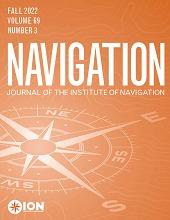Research ArticleOriginal Article
Open Access
Deterministic Heading-Independent Celestial Localization Measurement Model
Ilija Jovanovic and John Enright
NAVIGATION: Journal of the Institute of Navigation September 2022, 69 (3) navi.529; DOI: https://doi.org/10.33012/navi.529
Ilija Jovanovic
Aerospace Engineering, Ryerson University, Ontario, Canada
John Enright
Aerospace Engineering, Ryerson University, Ontario, Canada

REFERENCES
- ↵
- Bennett, G. G.
- ↵
- Crassidis, J. L.,
- Markley, F. L., &
- Cheng, Y.
- ↵
- Eisenman, A. R.,
- Liebe, C. C., &
- Perez, R.
- ↵
- Enright, J.,
- Barfoot, T., &
- Soto, M.
- ↵
- Jewell Instruments
- ↵
- Jovanovic, I., &
- Enright, J.
- ↵
- Jovanovic, I., &
- Enright, J.
- ↵
- Li, R.,
- Di, K.,
- Hwangbo, J., &
- Chen, Y.
- ↵
- Li, R.,
- Di, K.,
- Matthies, L.,
- Arvidson, R.,
- Folkner, W. M., &
- Archinal, B.
- ↵
- Li, R.,
- Squyers, S. W.,
- Arvidson, R. E.,
- Archinal, B. A.,
- Bell, J.,
- Cheng, Y.,
- Crumpler, L.,
- Des Marais, D. J.,
- Di, K.,
- Ely, T. A.,
- Golombek, M.,
- Graat, E.,
- Grant, J.,
- Guinn, J.,
- Johnson, A.,
- Greeley, R.,
- Kirk, R. L.,
- Maimone, M.,
- Matthies, L. H., …
- Xu, F.
- ↵
- Mills, D. L.
- ↵
- Pavlis, N. K.,
- Holmes, S. A.,
- Kenyon, S. C., &
- Factor, J. K.
- ↵
- Petit, G., &
- Luzum, B.
- ↵
- Shuster, M. D.
- ↵
- Shuster, M. D., &
- Oh, S. D.
- ↵
- Wei, X.,
- Cui, C.,
- Wang, G., &
- Wan, X.
- ↵
- Wertz, J. R.,
- Everett, D. F., &
- Puschell, J. J.
- ↵
- Ning, X., &
- Fang, J.
- ↵
- Zhan, Y.,
- Zheng, Y.,
- Li, C.,
- Wang, R.,
- Zhu, Y., &
- Chen, Z.
In this issue
NAVIGATION: Journal of the Institute of Navigation
Vol. 69, Issue 3
Fall 2022
Deterministic Heading-Independent Celestial Localization Measurement Model
Ilija Jovanovic, John Enright
NAVIGATION: Journal of the Institute of Navigation Sep 2022, 69 (3) navi.529; DOI: 10.33012/navi.529
Jump to section
Related Articles
Cited By...
- No citing articles found.






